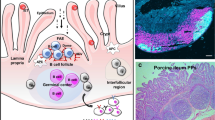Summary
The equine Paneth cell response to a shift in the microbial balance of the intestinal tract was studied by inducing an acute episode of alimentary laminitis in 6 mature ponies. The normal bacterial population of the gut was modified by administration of a carbohy-drate-rich ration. During acute laminitis a dramatic degranulation of the Paneth cells occurred in the intestinal glands throughout the duodenum, jejunum, and ileum. Bacteriocidal lysozyme, which was immunohistochemically identified as a component of the Paneth cell secretory granule, was evident in the glandular lumina and in degranulated Paneth cells. These results indicate that lysozyme is secreted by the equine Paneth cell in an apparent attempt to regulate the changing microbial population induced by carbohydrate overload of the gut. From these observations, it is suggested that the Paneth cell plays a role in the mucosal defense system of the equine intestinal tract.
Similar content being viewed by others
References
Behnke O, Moe H (1964) An electron microscope study of mature and differentiating Paneth cells in the rat, especially of their endoplasmic reticulum and lysosomes. J Cell Biol 22:633–652
Bladen H, Hageage G, Harr T, Pollock F (1973) Lysis of certain organisms by the synergistic action of complement and lysozyme. J Dent Res 52:371–376
Blood DC, Radostitts OM (1989) Veterinary medicine. A textbook of the diseases of cattle, sheep, pigs, goats and horses, 7th edn. Balliere Tindall, London Philadelphia Sydney, pp 1363–1367
Chipman DM, Sharon N (1969) Mechanism of lysozyme action. Science 165:454–465
Elmes ME, Stanton MR, Howells CHL, Lowe GH (1984) Relation between the mucosal flora and Paneth cell population of human jejunum and ileum. J Clin Pathol 37:1268–1271
Erlandsen SL, Chase DG (1972a) Paneth cell function: phagocytosis and intracellular digestion of intestinal microorganisms. I. Hexamita muris. J Ultrastruct Res 41:296–318
Erlandsen SL, Chase DG (1972b) Paneth cell function: phagocytosis and intracellular digestion of intestinal microorganisms. II. Spiral microorganisms. J Ultrastruct Res 41:319–333
Erlandsen SL, Parsons JA, Taylor TD (1974) Ultrastructural immunocytochemical localization of lysozyme in the Paneth cells of man. J Histochem Cytochem 22:401–413
Garner HE (1980) Update on equine laminitis. Veterinary Clinics of North America: Large Animal Practice 2:25–32
Garner HE, Coffman JR, Hahn AW, Hutcheson DP, Tumbleson ME (1975) Equine laminitis of alimentary origin: An experimental model. Am J Vet Res 36:441–444
Garner HE, Hutcheson DP, Coffman JR, Hahn AW, Salem C (1977) Lactic acidosis: a factor associated with equine laminitis. J Anim Sci 45:1037–1041
Garner HE, Moore JN, Johnson JH, Clark L, Amend JF, Tritschler LG, Coffman JR, Sprouse RF, Hutcheson DP, Salem CA (1978) Changes in the caecal flora associated with the onset of laminitis. Equine Vet J 10:249–252
Glynn AA, Milne CM (1965) Lysozyme and immune bacteriolysis. Nature 207:1309–1310
Hally AD (1958) The fine structure of the Paneth cell. J Anat 92:268–277
Klockars L, Osserman EF (1974) Localization of lysozyme in normal rat tissues by an immunoperoxidase method. J Histochem Cytochem 22:139–146
Masty J (1984) Ultrastructural, histochemical, immunocytochemical and light microscopic observations of the terminal portion of the obstructed and normal equine small intestine. [PhD Thesis] Purdue University, West Lafayette, Indiana
McNabb TC, Tomasi TB (1981) Host defense mechanisms at mucosal surfaces. Ann Rev Microbiol 35:477–496
Moore JN, Garner HE, Berg JN, Sprouse RF (1979) Intracecal endotoxin and lactate during onset of equine laminitis: a preliminary report. Am J Vet Res 4:722–723
Peeters T, Vantrappen G (1975) The Paneth cell: a source of intestinal lysozyme. Gut 16:553–558
Satoh Y (1988) Effect of live and heat-killed bacteria on the secretory activity of Paneth cells in germ-free mice. Cell Tissue Res 251:87–93
Satoh Y, Vollrath V (1986) Quantitative electron microscopic observations on Paneth cells of germfree and ex-germfree Wistar rats. Anat Embryol 173:317–322
Satoh Y, Ishikawa K, Ono K, Vollrath L (1986a) Quantitative light microscopic observations on Paneth cells of germ-free and ex-germ-free Wistar rats. Digestion 34:115–121
Satoh Y, Ishikawa K, Tanaka H, Ono K (1986b) Immunohistochemical observations of immunoglobulin A in the Paneth cells of germ-free and formerly-germ-free rats. Histochemistry 85:197–201
Trier JS (1963) Studies on small intestinal crypt epithelium I. The finestructure of the crypt epithelium of the proximal intestine of fasting humans. J Cell Biol 18:588–620
Author information
Authors and Affiliations
Rights and permissions
About this article
Cite this article
Masty, J., Stradley, R.P. Paneth cell degranulation and lysozyme secretion during acute equine alimentary laminitis. Histochemistry 95, 529–533 (1991). https://doi.org/10.1007/BF00315751
Accepted:
Issue Date:
DOI: https://doi.org/10.1007/BF00315751




